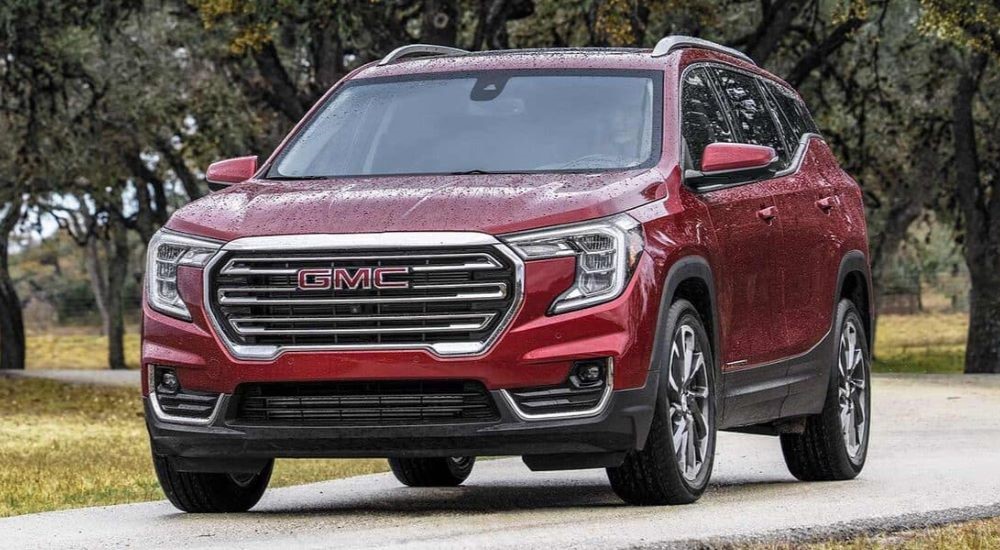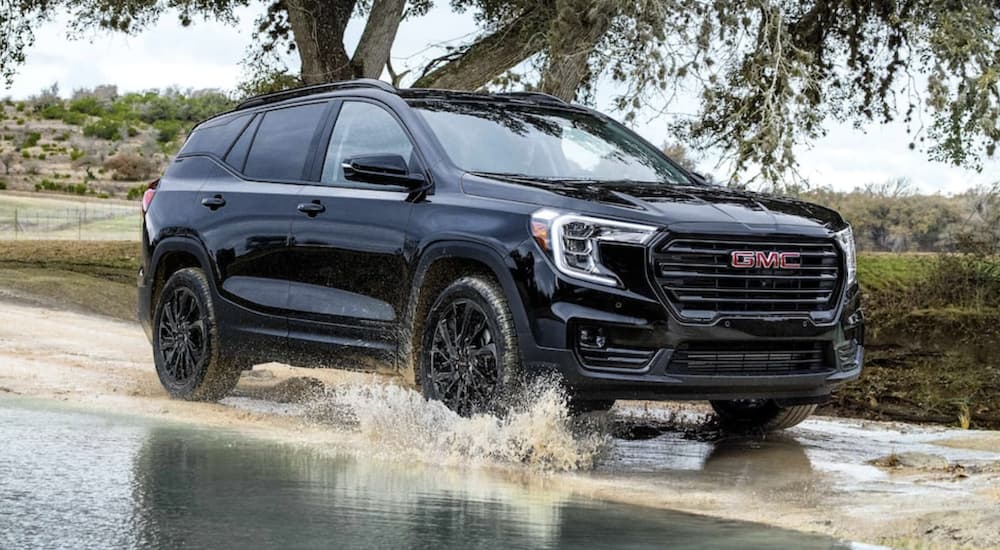If you’ve shopped for an SUV recently and your local GMC dealer wasn’t on the list of stops, you probably test drove a lot of great looking vehicles with similar styling–sleek rooflines, stylized grilles, and clever contouring–that made them hard to tell apart. The truth is, most automakers have embraced a softer, more car-like sameness with their compact SUV offerings. Still, despite the overarching presence of these daintier SUVs, GMC dug in its heels and said, “no way,” choosing to stick with the original SUV design intent: unfussy truck-like styling.
Amidst the American obsession with “lite” SUVs and crossovers, and the “vanillafication” trend that emerged to satisfy it, GMC offers an alternative with the 2023 Terrain. The compact Terrain inherits its beefy, boxy DNA from its big brother, the Yukon, and proudly defies the new normal of dainty, curvy, sedan-like design. With available all-wheel drive, the Terrain holds its own in challenging driving conditions, like a good SUV should, while also looking like a traditional SUV.
Despite GMC’s adherence to old-school SUV design, the Terrain’s upscale cabin still manages to beat the competition. The result is a well-rounded SUV that’s true to its rugged roots, yet mindful of the importance of comfort and convenience. Why have most manufacturers abandoned the SUV’s traditional styling for a more car-like version, especially as traditional sedans continue to drop in popularity? The answer lies in a complex, pea-soup opaque story of corporate profits, environmental pressure, and consumer demand. Here are the reasons behind the SUV’s evolution from a true utility vehicle to a cute, charming, and very car-like crossover–except for the GMC Terrain.
Pursuit of Global Dominance
If you want to know why any given company makes any given decision, follow the money trail. Today’s auto manufacturers are under big pressure to supply affordable models to a vehicle-dependent market on a global scale. These manufacturers, often owned by large parent companies, look for economies of scale to answer demand. How can they build a better, safer automobile with global appeal? The answer is standardization. Unfortunately, with standardization comes vanillafication.
Automakers’ chief goal is to build vehicles with universal appeal. Like the philosophy of any mass marketed product, the idea is to minimize specialty features and stick to a simple design that transcends cultural preferences and achieves mass acceptance. In other words, today’s automotive designers color inside the lines to set themselves up for category dominance. This practice is so commonplace that competing manufacturers, including Mazda, Ford, Kia, and Hyundai, often collaborate on a single shared vehicle platform. As EV technology expands, many experts anticipate more resource-sharing, which portends even more uniformity.
Beyond mass appeal, a consolidated approach also simplifies the manufacturing process, creating efficiencies that increase margins and keep sticker prices affordable. This strategy is evident in the subcompact and compact SUV categories, with many models starting in the low $20,000 range. Sadly, design innovation often suffers at the hands of efficiency. As a result, most automotive design teams ignore design “sameness,” focusing instead on infusing these mass-appeal new models with the equipment and features that attract the most diverse buyer demographic.
GMC’s decision to buck the globalization trend and maintain the SUV status quo with the 2023 Terrain speaks to the automaker’s historical Detroit “Big 3” roots. Americans like rugged vehicles, and the more rugged, the better. For some compact SUV buyers, that means selecting an SUV that actually looks like an SUV, not a raised sedan with cargo space that a global automaker labels a “crossover.” Car and Driver nails it, citing the Terrain’s “attractively boxy, assertive look” as an outlier in the category.
Rules and Regulations
Hidden beneath the engineers’ schematics and CAD drawings for future vehicle designs are binders of current and future regulatory guidelines that every new design must follow. Chief among them are emissions standards that regulate fuel economy minimum ratings, aerodynamics, and exhaust system components. Unfortunately for automotive designers, every country has different requirements, so designs often must adhere to the strictest versions, which limits creativity and forces similarities with the competition.
With fewer performance-related competitive advantages, strategic automakers should turn to aesthetics and technology for a leg up. With the Terrain, GMC did just that, eschewing the default vanilla design aesthetic for a boxier curb profile. While some critics call it outdated, GMC’s design incorporates a more angular side profile and a slightly sloped roofline, demonstrating how the Terrain appeals to today’s buyers by successful blending traditional and modern design cues.
As the industry pivots to an electrified future to meet aggressive regulatory benchmarks, GMC remains steadfast in its efforts to maintain design integrity throughout its SUV and pickup truck lineups while adhering to new laws and requirements instead of compromising its brand integrity. It’s a more difficult strategy that requires planning and creativity, but doing so gives buyers more opportunities to differentiate themselves from their neighbors. The industry’s migration away from heterogenous design could affect America’s love affair with SUVs. Luckily, manufacturers like GMC are taking steps to maintain diversity in the SUV category.
Subliminal Consumer Pressure
Consumer demand is at the heart of any business’s product strategy, but when it comes to automobiles, the correlation is a little fuzzy. Buying habits reflect an acceptance of vanilla-styled SUVs and crossovers, not a desire for differentiation. As a result, uniform design hasn’t slowed sales for many manufacturers. However, a subset of buyers isn’t served by the compact SUV category’s lack of diversity. Could this erode the SUV body style’s popularity over time? According to yahoo.com, sedans represented 21.4 percent of the 3.6 million new vehicles in the first quarter of 2023 after dipping to an all-time low of under 20 percent just two years prior.
It is those buyers looking for a vehicle that reflects their idea of an SUV that GMC serves with the Terrain. The 2023 Terrain invokes memories of the old-school Jimmy, echoing its designed-for-utility practicality. Currently in its second generation, the newest GMC Terrain has triggered an uptick in sales after a COVID-related dip from its peak of over 114,000 vehicles in 2018. Robust sales clearly indicate that some portion of the compact SUV buying public prefer more rugged-looking SUVs.
Why GMC Won’t Let Go of Its Boxy SUV Roots
Known for its positioning as a premium brand, GMC has cornered the market on building trucks and SUVs for buyers with active lifestyles who have a few extra bucks to pay for upgraded cabin amenities and flashier bells and whistles. Beneath that winning formula, the GMC lineup still retains a certain edginess and some grit that transcends the luxury-minded buyer. The Terrain exemplifies the convergence of mud-soaked capability and upscale refinement, cloaked in a veneer of affluence.
The cost/benefit analysis of building a unique SUV for the ultra-competitive compact SUV probably doesn’t justify a deviation, but GMC has stuck to the plan regardless. Perhaps the overarching General Motors strategy demands differentiation to ensure vehicles like the GMC Terrain stand out from competitive models in the family of brands. Whether this strategy is sustainable in the era of climate change remains to be seen.
While other manufacturers are distracted by design and manufacturing efficiencies, global market share, and staying ahead of ever-increasing regulatory requirements, GMC holds steady to its roots, offering buyers plenty of high-tech features and enough glossy curb appeal to trigger pride of ownership without abandoning the utility that the SUV body style’s name implies. If you’re in the hunt for something slightly different with a dose of throwback to traditional boxy SUVs, the 2023 GMC Terrain may just fit the bill.






